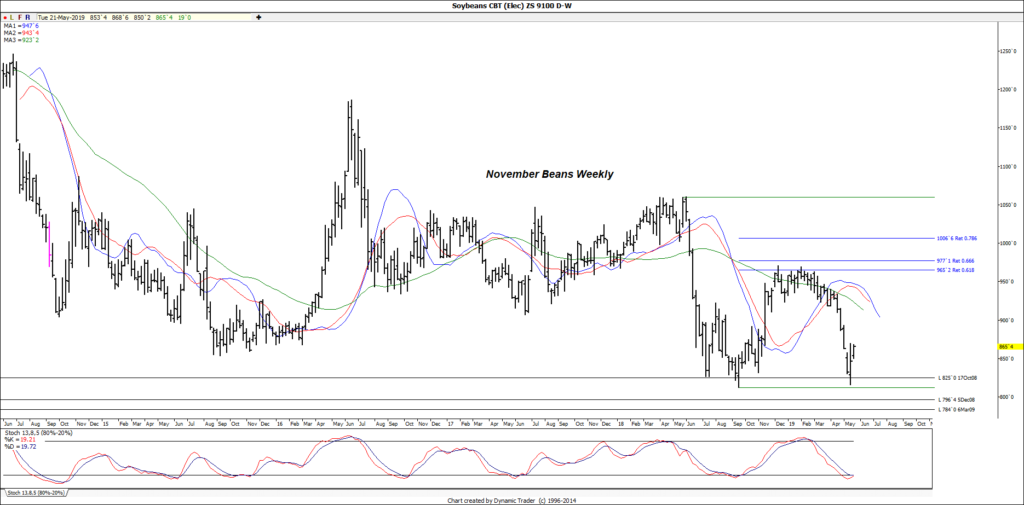By: Dan Hueber –
Corn planting progress came in pretty much right at expectations at 49% but obviously is served as some type of long-overdue wakeup call for traders as corn prices gapped higher once again overnight and are now challenging the highs of the calendar year. Maybe it was the fact that Illinois, the second largest corn-producing state, is still just 24% planted compared with 89% on an average year. Or possibly it was the weather outlook that promises more rains across this region right until the Memorial Day weekend, or even the fact that the Commitments of Traders report told us that managed spec funds had covered very little of their record short position. In reality, it was undoubtedly a combination of all three things. I mentioned yesterday we gapped higher to begin the week, which was the second gap up since prices turned higher on the 13th and often times a second gap, assuming that it holds, is considered the measuring gap. If that is the case this time, it would provide us with an upside target for July corn at 4.27 and in December corn 4.31 to 4.36 to an extreme of 4.47/4.50. By no means there is nothing that would assure we will run that far, or even that the gaps will hold through tomorrow for that matter, but for now, it would appear that the bears in the corn market who were uber-confident just a week ago are or at least should be, headed for the exits.
Of course, we have yet to reach the prevented plant dates for corn for most of the country, but it could be a worthwhile exercise to begin poking in different number to see just what could happen with less than optimum yields this year. On the May estimate, the USDA used a planted acreage of 92.8 million and a trendline yield of 176 bpa to come up with total production of 15.033 billion bushels. I do not believe many consider that acreage number as realistic, but how much will be lost? Last week IEG published a projected 90.692 million acres for corn so that would seem to be as good as starting point as any. If this were correct and we still used a 176 yield, the corn crop would come in around 14.685 billion bushels, 348 million below this initial estimate. Not earth-shattering as carryout would still be north of 2 billion bushels. Of course, considering the fact that 70% of the acreage will have been planted after the 10th of May, the 176 yield does not seem realistic either. As a rough guide, each 1-bushel reduction in yield would equate to 83.4 million bushels in production. Just for argument sake, if we take the average yield of the past five years it would be 173.4 and using that, we would have production of 14.468 billion and potential for ending stocks to dip down to around 1.920 billion. Realistically, not the kind of figures that make for significant bull markets but could set the stage for a sub-2-billion-bushel carryout for the first time since the 2015/16 crop year. If that were the case, 4.30 to 4.50 corn would seem realistic.
Needless to say, none of this is positive news for the bean market, and the price action to date reflects such. Interestingly enough, the technical picture in this market would seem to be suggesting we could at least have a corrective rebound in store. Using the same exercise that we just did in corn, IEG bumped their bean acreage estimate to 86.437 million, an increase of 1.84 million over the USDA. If we stay with the trendline yield of 49.5 bpa, this would increase production 88 million bushels to 4.238 billion and potentially push ending stocks north of 1-billion bushels. We have not posted a nationwide yield below 49 bpa since 2015/16 crop year but each 1-bushel reduction in bean yields would equate to 85.6 million bushels of production so a 48.5 bpa would potentially take carryout down to 970 million and a 47.5 bpa (2014/15) would lower it to 885 million. Granted it is difficult to paint anything remotely bullish in the bean complex, particularly when the USDA already has usage at the third highest on record but when in the mind of the trade at least, yields are already being threatened, it is not difficult to conceive why we could post a corrective rally.
Granted, a change in the weather forecast tomorrow could render this all an exercise in futility, seeing that does not appear to fit pattern we are in, I suspect we have the potential to extend this advance a bit further. All that said, now is not the time to become greedy or to throw out your marketing plans. Weather markets by nature are relatively short-lived, and it almost seem cruel to use the adage but as they say, you have to make hay when the sun is shining.
